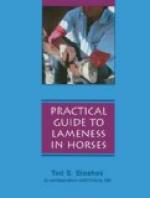Some hyperthermia is to be recognized in acute inflammation, by comparing the extremities. In the fore legs, navicular disease is differentiated by noting absence of contraction at the heel. By use of the hoof testers one may recognize evidence of inflammation of the navicular apparatus. In inflammation of the posterior ligaments of the pastern joint, there is also absence of the characteristic stumbling which is seen in navicular disease.
Treatment.—Rest is the first requisite, and in addition every mechanical means possible to change the center of gravity in the phalangeal region, is to be employed. This is best accomplished by shortening the toe and paring the sole at the toe as much as conditions will permit. The heel is raised by means of a shoe with moderately high heel calks.
The iodin-glycerin combination heretofore mentioned may be applied and the parts covered with cotton and bandage. Subjects require from three weeks to several months’ rest and must be returned to work carefully, lest the incompletely regenerated tissues suffer injury.
Regeneration of tissue in such cases, as has been pointed out, is slow and sufficient time for complete recovery must be allowed or relapses will occur.
Fracture of the First and Second Phalanges.
Etiology and Occurrence.—Fractures of the first phalanx (suffraginis) occur with respect to frequency, second to pelvic fractures. Often, almost insignificant injuries cause phalangeal fractures. On city streets, horses shod with shoes having long calks get caught in frogs of street railways or by slipping on rails, and phalangeal bones are often broken. The author observed a case of comminuted fracture of both the first and second phalanges (suffraginis and corona) in a polo pony caused by making a sudden turn while in action in a contest on the turf.
Symptomatology.—Fracture of the phalanges is nearly always signalized by lameness, and this is marked during the period of weight bearing. Lameness is usually intense and where the pathognomonic symptom (crepitation) is not recognized, the intensity of the claudication, when other causes are absent, is indicative of fracture. The subject does not bear weight upon the affected member and where pain is intense, the foot is held in an elevated position and swung back and forth. In hind legs the member is often flexed in abduction and held in this position for several minutes, being rested on the ground only during short intervals. When compelled to walk, if pain is excruciating, the animal hops with the sound leg, no weight being supported by the fractured member.




